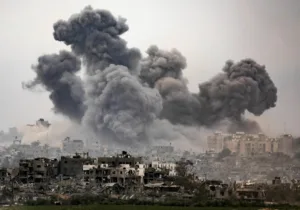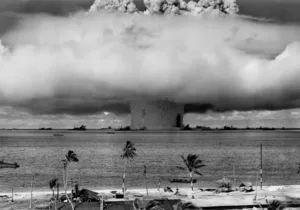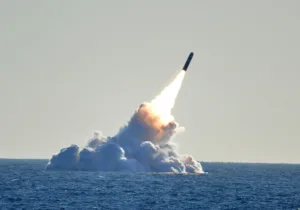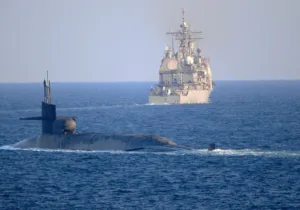At a meeting this summer with the nation’s highest-ranking national security leaders, President Trump reportedly told the group he wanted a tenfold increase in the U.S. nuclear arsenal. The president’s advisers allegedly told him that to do so would not only cause a break with decades of U.S. nuclear doctrine but would be in violation of international disarmament treaties.
Here is what you should know about nuclear weapons:
1. A nuclear weapon is an explosive device that produces destructive energy by splitting the nucleus of an atom from material that is capable of sustaining a nuclear fission chain reaction. The two primary types of nuclear bombs use either fission (the process of splitting the nucleus of an atom into two or more smaller nuclei) or a two-stage process that uses fission and fusion (the process by which multiple hydrogen nuclei join together to form a heavier nucleus). Nuclear weapons that use fission alone are often referred to as “atomic bombs” (A-bombs) while those that use fission and fusion are called “hydrogen bombs” (H-bombs) or thermonuclear weapons. There are three types of nuclear weapons based on the material—hydrogen, plutonium, uranium—used to create the nuclear fission reaction.
2. Nuclear weapons can be either tactical or strategic. A tactical nuclear weapon is a nuclear weapon designed for use on a battlefield in military situations, where friendly forces may be in relatively close proximity. A strategic nuclear weapon refers to a nuclear weapon designed to be used on targets in territory far from the battlefield as part of a strategic plan, such as on military bases, weapons factories, or military command centers.
3. Uranium bombs are relatively easy to design and make but require a material that is difficult to obtain: purified uranium-235. The uranium extracted from the Earth contains only 0.7 percent of the U-235 isotope, the fissile material in a nuclear bomb or nuclear reactor. The remaining 99.3 percent is mostly the U-238 isotope, which does not contribute directly to the fission process and must be removed through the process of “enrichment.” The process is difficult and expensive. About 90 percent of world enrichment capacity is in the five nuclear weapons states (see item 7). The bomb that destroyed Hiroshima was a uranium bomb.
4. Plutonium bombs are more difficult to design and make but use a material that is easier to acquire: plutonium-239. Weapons-grade plutonium can be created using a nuclear power plant. The natural uranium fuel used in the reactor can be burned for about three months to create fissile material usable in a nuclear bomb. But the process of creating a plutonium bomb requires sophisticated technology and expertise, and is far beyond the capabilities of most nations, much less terrorist groups. The bomb that destroyed Nagasaki was a plutonium bomb.
5. Hydrogen bombs (thermonuclear weapons) are the most difficult to make since they require a uranium or plutonium bomb to serve as the “trigger” for the fusion reaction. They also require extensive testing to ensure that the process will work. Only six countries—China, France, India, Russia, the United Kingdom, and the United States—have conducted thermonuclear weapon tests.
6. The destructive energy of nuclear weapons, which is called the explosive yield, is measured in TNT equivalent, usually in kilotons (kt—thousands of tons of TNT) or megatons (Mt—millions of tons of TNT). The bomb dropped on Hiroshima was approximately 13 to 18 kt, while the bomb used on Nagasaki was 20 to 22 kt. The most powerful nuclear weapon ever detonated was Tsar Bomba, a hydrogen bomb tested by the Soviet Union in 1961. The bomb had a yield of 50,000 kt (50 Mt)—about 4,000 times more energy than the bomb used on Hiroshima—and had a destructive radius of 15 miles. (You can see a video of the testing here.) The largest nuclear weapon currently in the U.S. stockpile, the B83, has a yield of 1,200 kt (1.2 Mt).
7. Apart from the explosive yield, much of the danger of nuclear weapons comes from radioactive fallout. Radioactive material can attach itself to dirt and other debris during the explosion and settle over a broad area. For survivors of a nuclear blast, this radiation hazard could pose a danger for months or years after the attack. In the 1950s, fallout shelters were created throughout the United States to provide shelter after an attack. Although they would not provide protection from a direct hit, fallout shelters would allow people to escape exposure while the short-lived radiation expended itself.
8. The Treaty on the Non-Proliferation of Nuclear Weapons of 1970 (aka the Non-Proliferation Treaty or NPT) recognizes five states as nuclear-weapon states: the United States, Russia, the United Kingdom, France, and China (these are also, not coincidently, the five permanent members of the United Nations Security Council). India and Pakistan have also tested nuclear devices. Israel is believed to have nuclear weapons, though they have never admitted to it or tested them. North Korea is believed to have nuclear bombs but no missiles that can deliver them.
9. The U.S. Defense Department maintains about 4,760 nuclear warheads, according to estimates by the Bulletin of the Atomic Scientists. Of this number, they estimate that approximately 2,080 warheads are deployed while 2,680 warheads are in storage. In addition to the warheads in the Defense Department stockpile, approximately 2,340 retired but still intact warheads are in storage under the custody of the Energy Department and awaiting dismantlement, for a total U.S. inventory of roughly 7,100 warheads.
10. As the Commander in Chief of the U.S. armed forces, the president maintains sole authority to authorize the launch of nuclear weapons. Military doctrine recommends that the president consult with senior commanders in making a decision to employ nuclear weapons, but he is not bound to do so. The president is accompanied at all times by a military officer carrying a briefcase that contains a secure satellite communication radio and handset, the nuclear launch codes known as the “Gold Codes,” and the President’s Decision Book on options for using nuclear weapons. This briefcase is officially known as the “president’s emergency satchel,” but it is often referred to as the “football.” (According to Smithsonian Magazine, it acquired its name from an early nuclear war plan code-named “Dropkick.” “Dropkick” needed a “football” in order to be put into effect.) The president carries a personal identification code—called “the biscuit”—that is needed to confirm nuclear launches. (Bill Clinton reportedly misplaced his “biscuit” for several months while in office.)
—
Joe Carter is an adjunct professor of journalism at Patrick Henry College, an editor for several organizations, and the author of the NIV Lifehacks Bible.
Photo Credit: A nuclear weapon is detonated at Bikini Atoll in the Marshall Islands in 1946. (Image has been colorized.) Source: US Government (via Flickr).







 Sponsor a student for Christianity & National Security 2024
Sponsor a student for Christianity & National Security 2024